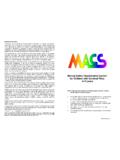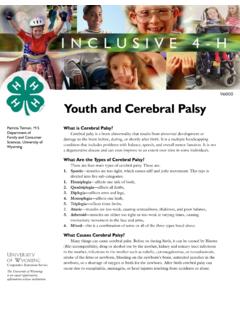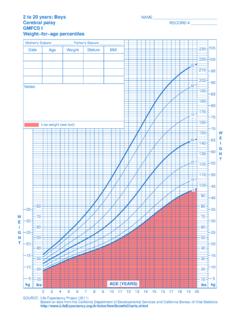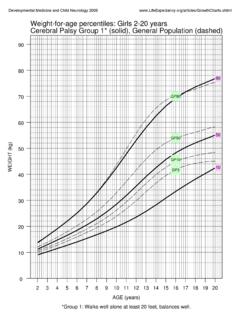Transcription of 196 Anaesthetic management of patients with …
1 Sign up to receive ATOTW weekly - email ATOTW 196 anaesthetic management of patients with cerebral palsy 13/09/2010 Page 1 of 7 Anaesthetic management OF patients with cerebral palsy ANAESTHESIA TUTORIAL OF THE WEEK 196 13TH SEPTEMBER 2010 Dr Mimi Darcey, Senior Anaesthetics Registrar Royal Hobart Hospital, Tasmania, Australia Correspondence: QUESTIONS Before continuing, try to answer the following questions. The answers can be found at the end of the article, together with an explanation. 1. Which of the following can cause of cerebral palsy ? a. Perinatal cerebral hypoxia, ischaemia or trauma. b. Antenatal infections, cerebral maldevelopment, genetic abnormalities. c. Postnatal central nervous system infection or trauma. d. All of the above are possible. 2. All cerebral palsy patients are significantly intellectually impaired. True or False? 3. What is the commonest clinical type of cerebral palsy ? a. Dyskinetic b. Spastic c. Mixed d.
2 Ataxic 4. Which is not commonly associated with cerebral palsy ? a. Malnutrition, impaired immune system b. Epilepsy c. Suxamethonium apnoea d. Sensory deficits and communication disorders INTRODUCTION cerebral palsy (CP) is a group of non-progressive disorders of motion and posture. It results from injury to the developing brain during the antenatal, perinatal or postnatal period. Clinical manifestations are related to the area of central nervous system (CNS) affected. The clinical picture may vary considerably, from high functioning mild monoplegia with normal intellect to severe spastic quadriplegia with mental retardation. Perioperative challenges include: seizure control, optimization of respiratory function, gastro-oesophageal reflux, management of pain, muscle spasm, nausea/vomiting and effective communication by close involvement of carers. Where possible a multidisciplinary team should be involved including the surgeon, paediatrician, anaesthetist, acute pain service, specialised nurses, physiotherapist and speech pathologist.
3 Understanding the disease aetiology, clinical manifestations and management will help improve perioperative care of patients with cerebral palsy . Sign up to receive ATOTW weekly - email ATOTW 196 anaesthetic management of patients with cerebral palsy 13/09/2010 Page 2 of 7 AETIOLOGY In the developed world the prevalence of CP is relatively stable at per 1000 live births, despite improvements in antenatal and perinatal care. Aetiology of CP is multifactorial and results from injury to the developing brain. The contribution of specific causes is still debated, and causation in individual cases is usually difficult to establish. Recognised risk factors for developing CP include: perinatal hypoxia, prenatal infection, congenital abnormalities, trauma, and genetic predisposition. CP is likely the final common endpoint from a number of factors affecting early cerebral development, rather than any one specific event.
4 In premature infants, CP is commonly a result of periventricular haemorrhages. For infants born after 34 weeks gestation approximately 50% of spastic quadriplegia CP is caused by prenatal problems including brain maldevelopment, stroke, infections (toxoplasmosis, rubella, cytomegalovirus, herpes virus TORCH) or genetic disorders. Intrapartum hypoxia (birth asphyxia) for term infants is now believed to cause only 6% of CP. This is less common than previously thought. Postnatal causes include meningitis, viral encephalitis, hydrocephalus, trauma, surgical lesions and their treatment. CLASSIFICATION CP encompasses a variety of neurological syndromes and is commonly classified by characteristics of neurological dysfunction (spastic, dyskinetic, ataxic, and mixed) and extremity involved (quadriplegia, hemiplegia, diplegia, and monoplegia). Swedish Classification for CP (complex cases may defy classification) Spastic 70% (most common clinical manifestation) Quadriplegia 27% of all cases of CP Diplegia 21% Hemiplegia 21% Dyskinetic 10% (often normal intellect but difficulties with communication) Dystonia (maintained twisting position of torso and extremities) Athetosis (slow, purposeless, distal movements) Chorea (quick, jerky, proximal) Ataxic 10% Intention tremor and head tremor (titubation) Mixed 10% spastic athetoid COMMON SURGICAL PROCEDURES 60% Orthopaedic procedures: major multilevel surgery involving tenotomies/osteotomies, soft tissue release/tendon transfers, and botulinum toxin injections.
5 10% Dental extractions and restorations. 10% Gastrostomy and anti-reflux procedures. 10% Imaging. 10% Other: neurosurgery, urology, ophthalmology, ENT and insertion of infusion devices. Sign up to receive ATOTW weekly - email ATOTW 196 anaesthetic management of patients with cerebral palsy 13/09/2010 Page 3 of 7 CLINICAL PROBLEMS AND COMORBIDITIES Central nervous system Epilepsy affects approximately 30% of CP patients , and is most common in spastic hemiplegia. Tonic-clonic and complex-partial seizures are common. Normal anticonvulsants should be continued throughout the perioperative period. Understanding anticonvulsant side effects and drug interactions is important. Visual and hearing deficits, behavioral disorders, communication problems and intellectual impairment are all common. However up to 60% of hemiplegic patients have normal intelligence. It is important to approach CP patients with sensitivity and to allow time for effective communication with patients and their carers.
6 Communication aids may be required such as sign cards or computer techniques. Attention deficit hyperactivity disorder (ADHD) is common in the higher functioning child. Depression and emotional lability are common in adolescents. These patients should be handled with care as communication difficulties may mask normal intellect. Cardiovascular Vascular access may be made difficult by multiple previous cannulations, scars, contractures of upper limbs, communication problems or behavioral issues. Chronic lung disease may lead to pulmonary hypertension, right ventricular hypertrophy or cardiac failure. Respiratory Respiratory disorders are ultimately a common cause of death. Problems include pulmonary aspiration, recurrent respiratory infections and chronic lung disease, poor cough with retention of secretions, poor nutritional state and impaired immunity. Scoliosis with restrictive lung defect may lead to cardiopulmonary compromise.
7 Pre-operative physiotherapy, bronchodilators or antibiotics may be required. The airway should be assessed for potential difficult laryngoscopy due to poor dentition, TMJ dysfunction and positioning problems. Formal airway assessment may be impractical and review of previous Anaesthetic charts may be helpful. Gastrointestinal Gastro-oesophageal reflux is common due to oesophageal dysmotility and spasm, abnormal lower oesophageal sphincter function and spinal deformity. Reflux is difficult to detect and night wakening may be the only indicator. Salivary drooling due to pseudobulbar palsy may occur with impaired swallowing. Tongue thrusting and poor head movements further contribute to difficult airway management . Poor oral feeding may lead to dehydration, malnutrition, failure to thrive, electrolyte imbalance and anaemia. Preoperative nasogastric feeding or gastrostomy may be required.
8 Allergies Latex allergy has been reported in CP patients , probably due to repeated exposure during multiple operative procedures. A history of such sensitivity must be noted and taken seriously. Medications Medical therapy for controlling seizures, spasticity, reflux, constipation and depression should be well understood, in particular with respect to side effects and potential interactions. Sign up to receive ATOTW weekly - email ATOTW 196 anaesthetic management of patients with cerebral palsy 13/09/2010 Page 4 of 7 Table 1: Common medications encountered in patients with CP PERIOPERATIVE management Pre operative Patient anxiety is common and may be exacerbated by poor understanding and communication difficulty. It can be useful having the primary carer with the patient at induction, in recovery and during the postoperative period. Parental anxiety and even aggression may be manifestations of previous experiences, stress, frustration, guilt and anger.
9 Respect and good communication is vital in gaining cooperation as well as allaying patient concerns and fears. Consent for any procedure needs to be clearly informed with risks and benefits discussed with the parent or guardian. CLASS DRUGS SIDE EFFECTS / DRUG INTERACTIONS Anticonvulsants Carbamazepine Sodium valproate Induction of hepatic enzymes, reduced duration of action of vecuronium. Impaired platelet function, increased risk of bleeding, hepatotoxicity, bone marrow suppression Antispasmodics Baclofen: GABA-B receptor agonist -Oral -Intrathecal (IT) pump Benzodiazepines: GABA-A receptor agonist Dantrolene (oral) Botulinum toxin -Presynaptic -Inhibit release of Ach -Onset 12h-7d, -Duration 2-6months -Botox max 12u/kg 1U=2-4 U of Dysport -Dysport max 30u/kg Apathy, urinary hesitancy, leg weakness, ataxia, dizziness. Overdose causes drowsiness, respiratory depression, rostral progression of hypotonia, loss of consciousness (Reverse with physostigmine or flumazenil, cease IT pump, respiratory support).
10 Occasional bradycardia and hypotension during GA, and delayed arousal after GA. Abrupt cessation may cause seizures Mechanical problems with IT pump, reservoir, infection with CNS spread Sedation, respiratory depression, dependence Muscle weakness, malaise, nausea, diarrhoea, skin rash, abnormal LFT s Dose dependent, reversible muscle denervation +/- atrophy if given long term. SE: Mild injection site discomfort 2-3 days. Fatigue, transient weakness of the injected muscle. Generalized weakness or systemic toxicity is rare. May potentiate action of muscle relaxants (not proven clinically). Can unmask subclinical Eaton-Lambert myasthenic syndrome. Prokinetic Cisapride Prolongs QT interval, increased risk of Torsades de Pointes Sign up to receive ATOTW weekly - email ATOTW 196 anaesthetic management of patients with cerebral palsy 13/09/2010 Page 5 of 7 Benefits of sedative premedication should be balanced against side effects and potential unpredictable drug responses.














